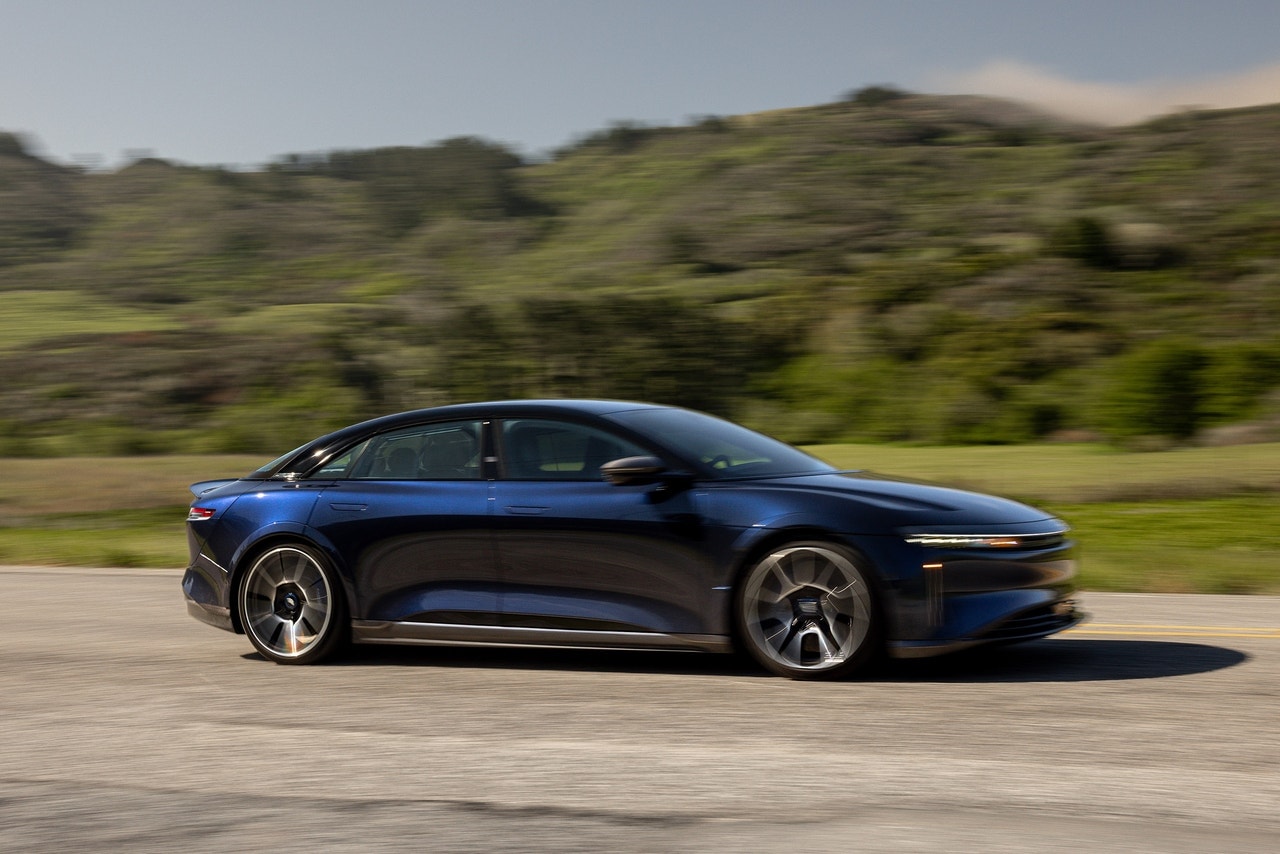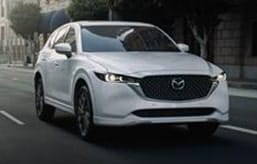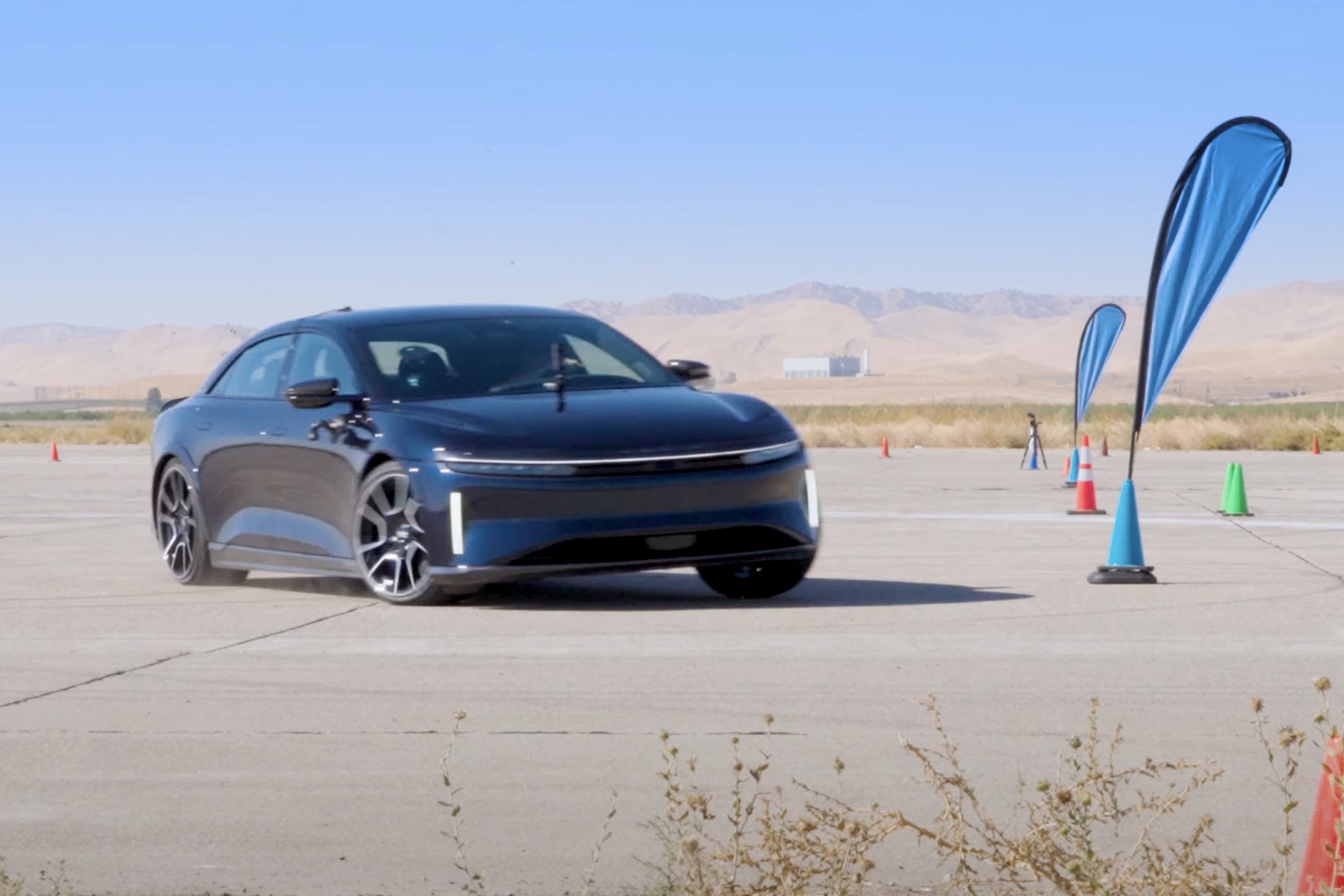- The Lucid Air Sapphire is the new king of the Edmunds U-Drags circuit.
- It ran our course in 27.9 seconds at 163.3 mph, besting the previous top dog, the McLaren 765LT, by nearly 2 seconds.
- How'd the Lucid absolutely destroy the McLaren? We dive into the data to find out.
How the Lucid Air Sapphire Beat the McLaren 765LT to Take the Edmunds U-Drags Crown
Let's dive into the data to see how Lucid's 1,234-hp Air Sapphire shaved nearly 2 seconds off the McLaren's U-Drags time
As fast as the McLaren 765LT is, we knew it was only a matter of time until something knocked it off the top of the Edmunds U-Drags leaderboard. Its sibling, the 750S, got about as close as you can get, tying the 765LT’s time but falling short of the LT’s top-speed benchmark. But we hadn’t yet raced any of the modern super-EVs, and wouldn’t you know it, one of them not only bested the 765LT, it outright demolished it. The super-EV in question was the Lucid Air Sapphire.
How we get the data
When we run U-Drags, we equip each vehicle with two Racelogic VBox units. (Using two gives us a backup in the off-chance data cannot be acquired by or extracted from one of them.) Those data recorders allow us to essentially drown in details — lateral and longitudinal g-forces, minute distances, speed and time down to two decimal points, we could go deeper — from every race.
It’s one thing to look and the final times and speed and call it a day, but in the case of the Lucid Air Sapphire, we want to see just what made it so much faster than the McLaren 765LT. Even though we didn’t race them against each other, we do have the VBox data from both cars and have pulled their best runs for this closer look at the numbers.
Edmunds U-Drags: Lucid Air Sapphire vs. McLaren 765LT
Lucid Air Sapphire | McLaren 765LT | |
|---|---|---|
| Power | 1,234 hp | 755 hp |
| Torque | 1,430 lb-ft | 590 lb-ft |
| Weight | 5,356 pounds | 2,952 pounds |
| 0-60 mph | 2.2 seconds | 3.1 seconds |
| Quarter-mile time | 9.2 seconds | 10.2 seconds |
| Quarter-mile speed | 149.6 mph | 144.6 mph |
| Max. speed at braking | 150.2 mph | 144.8 mph |
| Braking force | 1.39 g | 1.45 g |
| Braking distance | 676.2 feet | 626.0 feet |
| Braking time | 6.0 seconds | 5.7 seconds |
| Min. cornering speed | 19.8 mph | 22.3 mph |
| Cornering grip | 1.34 g | 1.09 g |
| Acceleration force | 1.16 g | 0.84 g |
| Final time | 27.9 seconds | 29.6 seconds |
| Final speed | 163.3 mph | 158.8 mph |
Who’s got what?
The McLaren 765LT Spider we raced packed a twin-turbo 4.0-liter V8 making 755 horsepower and 590 lb-ft of torque. Its mid-engine chassis is mainly made of carbon fiber, and this test car tipped our scales at just 2,952 pounds.
The Lucid Air Sapphire rocked up to U-Drags with a 118-kWh battery pack feeding three motors: two on the rear axle and one on the front. Maximum output is a mind-bending 1,234 hp and 1,430 lb-ft of torque. That’s ridiculous. Perhaps the only stat not in the Sapphire’s favor is its 5,356-pound as-tested weight. Then again, the Sapphire can comfortably scare the snot out of four people and their sentient luggage. The 765LT can only frighten two people, and a small duffle bag, at a time.
Launch party
Without a doubt, this is where the Sapphire makes up the most time against the 765LT. The Sapphire immediately bagged a 0.9-second advantage with its 2.2-second run to 60 mph versus the 765LT’s 3.1-second sprint. (Remember, we don’t subtract rollout from our 0-60 mph times.) That’s already a difficult deficit to make up, but the Sapphire positively buries the McLaren through the quarter mile with a blistering pass of just 9.2 seconds at 149.6 mph. The 765LT’s 10.2-second pass at 144.6 mph sees it a full second behind the Lucid and precisely 5 mph slower at this point in the race.
Make it up under braking?
Now, you must be thinking the McLaren is going to claw back some time under braking and around the cone — the U in U-Drags. And you’d be right, but it wasn’t as much as you might expect. Before the Lucid hit its carbon-ceramic brakes, it was traveling 150.2 mph. Maximum, and we mean maximum, braking delivered 1.39 g of force and slowed the Sapphire down to its minimum speed around the cone (19.8 mph) in 676.2 feet and 6.0 seconds.
By contrast, the McLaren was traveling 144.8 mph when we asked everything of its carbon-ceramic stoppers. Registering a strong 1.45 g of deceleration, the 765LT reached its minimum corner speed (22.3 mph) in 626 feet and 5.7 seconds. That neck-bending performance gave the McLaren 0.3 second back, but it’s still trailing the Lucid by 0.7 second at this point, and I’m afraid it’s not going to get any better for the McLaren.
As a side note, because of the different driving styles used by the cars’ respective drivers, a direct cornering comparison is difficult to achieve. Suffice it to say, from the moment each car begins to turn in to the moment it begins to apply power to exit, we estimate both cars and drivers spent precisely 2.3 seconds working their cornering magic. The Lucid extracted a whopping 1.34 g from its Pirelli P Zero Trofeo RS rubber on a sunny 88-degree day, while the McLaren pulled 1.09 g from its Pirelli P Zero Trofeo R tires on a sunny 60-degree day.
The sprint back
Once out of the corner, and unfortunately for the McLaren, the Lucid was right back in its element. From its minimal cornering speed, and now under full power, the Sapphire sees 1.16 g of longitudinal acceleration on its way to adding 143.6 mph in just 12.7 seconds. That’s an average of 11.3 mph per second. Wild.
The 765LT is no slouch, but even with its 2.5-mph minimum corner speed advantage, it could only add 136.5 mph before the line and needed 13.7 seconds to do so. Its 0.84 of longitudinal g-forces under acceleration shows just how much harder the Lucid is pulling than this hypercar.
The result
With a final time of 27.9 seconds at 163.3 mph, the Lucid Air Sapphire has definitively dethroned the previously untouchable McLaren 765LT and its 29.6-second, 158.8-mph pass. The easy, and correct, explanation is the Sapphire simply has more power and stronger acceleration thanks to its all-wheel-drive setup. But a closer look at the data shows its hefty weight wasn’t as much of a disadvantage as we thought it might be. Thanks to the Lucid’s trick side-to-side power shuffling and sophisticated stability control systems, it doesn’t lose much time when it’s not accelerating like crazy. The McLaren did what it could, clawing back time on the brakes, into and through the corner, but it was simply no match for the Sapphire’s 479 hp and 840 lb-ft advantage.
Will anything knock the Lucid off the top step? Will the upcoming Corvette ZR1 uphold the honor of the internal combustion engine or will another EV like the Porsche Taycan Turbo GT steal the crown? Keep watching our U-Drags videos to find out.





 by
by  edited by
edited by